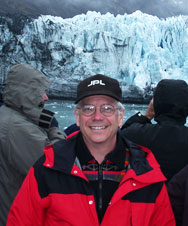George Hepner
Professor Emeritus (Ph.D. Arizona State, 1979) -- land resource analysis, geographic information systems, computer mapping applications quantitative methods
 Contact
Contact
- e-mail: george.hepner@geog.utah.edu
- CV
Interests
I have an increasing scholarly interest in the geographical dimension of international
terrorism, especially in Asia.
Personal interests include all that Utah has to offer: hiking, fishing, fine food
and wine
Education
- Ph. D. Arizona State University, School of Geographical Sciences (1979)
Courses Taught
- Geography of Terrorism and Homeland Security ( GEOG 3320/5320)
- Project Management (GEOG 6162)
- World Regional Geography (GEOG 1300)
Publications
- Zhang, Y., & Hepner, G. F. (2017). The Dynamic-Time-Warping-based k-means++ clustering and its application in phenoregion delineation. International Journal of Remote Sensing, 38(6), 1720-1736.
- Zhang, Y., & Hepner, G. F. (2017). Short-term phenological predictions of vegetation abundance using multivariate adaptive regression splines in the Upper Colorado River Basin. Earth Interactions, 21(1).
- Zhang, Y., G.F. Hepner and P.E. Dennison, “Delineation of Phenoregions in Geographically Diverse Regions using k-means++ clustering: A case study in the Upper Colorado River Basin,”GIScience and Remote Sensing, 49, No.2 (2012) pp 163-181.
- Hepner, G. F. and R. Medina, “Understanding the Geography of Terrorism,” Earth Imaging Journal, vol.9: 5, pp. 24-5 (Oct. 2012).
- Mondello, C., G.F. Hepner and S. Boerman, “ ASPRS Ten Year Remote Sensing Industry Forecast Phase VI,” Photogrammetric Engineering and Remote Sensing, (Nov. 2011) : pp. 1075-1089.
- Medina, R. L. K. Siebeneck & G. F. Hepner, “A Geographic Information Systems (GIS) Analysis of Spatiotemporal Patterns of Terrorist Incidents in Iraq 2004–2009”, Studies in Conflict & Terrorism, 34:11, (2011):pp. 862-882.
- Medina, R. and G. F. Hepner, “Advancing the Understanding of Sociospatial Dependencies in Terrorist Networks, “Transactions in GIS,( 2011), 15(5): 577-597.
- R. Medina and G. Hepner, The Geography of International Terrorism, An Introduction to Spaces and Places of Violent Non-state Groups,” Taylor and Francis/ CRC, pp. 258, April, 2013. http://www.routledge.com/books/details/9781439886861/
- R. Medina and G. Hepner, “Geospatial Analysis of Dynamic Terrorist Networks,” in Values and Violence: Intangible Aspects of Terrorism, pp.
151-168 (Springer) 2008 hardcover, paperback, 2009. - Zhang, Y., G.F. Hepner and P.E. Dennison, “Delineation of Phenoregions in Geographically
Diverse Regions using k-means++ clustering: A case
study in the Upper Colorado River Basin,”GIScience and Remote Sensing, 49, No.2 (2012) pp 163-181. - Mondello, C., G.F. Hepner and S. Boerman, “ ASPRS Ten Year Remote Sensing Industry
Forecast Phase VI,” Photogrammetric Engineering and Remote
Sensing, (Nov. 2011) : pp. 1075-1089. - Medina, R. L. K. Siebeneck & G. F. Hepner, “A Geographic Information Systems (GIS) Analysis of Spatiotemporal Patterns of Terrorist Incidents in Iraq 2004–2009”, Studies in Conflict & Terrorism, 34:11, (2011):pp. 862-882
- Medina, R. and G. F. Hepner, “Advancing the Understanding of Sociospatial Dependencies
in Terrorist Networks, “Transactions in GIS,(2011), 15(5):
577-597. - Zhang, Y., & Hepner, G. F. (2017). The Dynamic-Time-Warping-based k-means++ clustering and its application in phenoregion delineation. International Journal of Remote Sensing, 38(6), 1720-1736. doi:10.1080/01431161.2017.1286055
- Zhang, Y., & Hepner, G. F. (2017). Short-term phenological predictions of vegetation abundance using multivariate adaptive regression splines in the upper colorado river basin. Earth Interactions, 21(1). doi:10.1175/EI-D-16-0017.1
